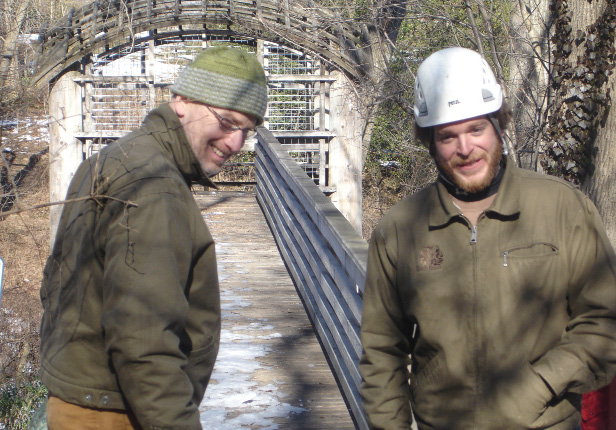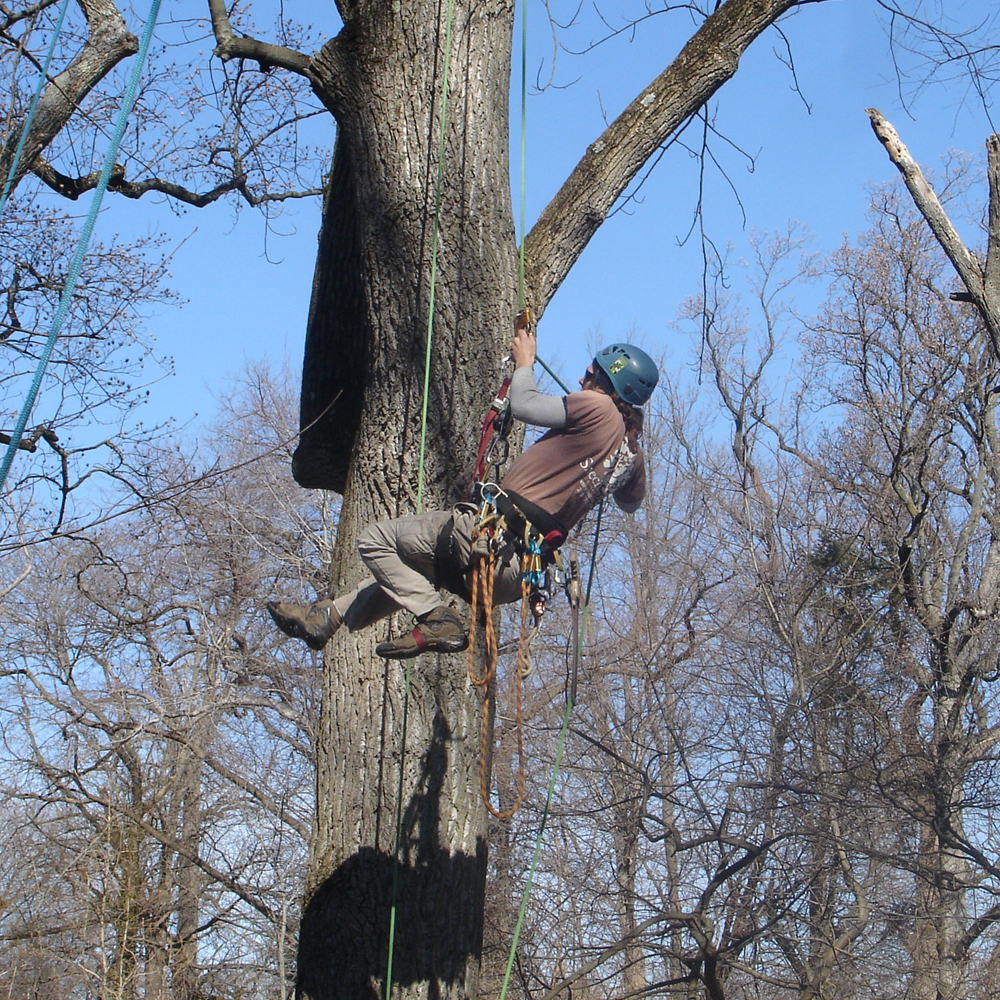Arborists to the rescue! Tree care experts Shechtman Tree Care, LLC greatly improved the environment around Pavilion in the Trees, located in Landsdowne Glen, behind the Horticulture Center in west Fairmount Park. Shechtman donated their arborist services and expertise for the day to tackle the intrusive overgrowth and hazardous trees surrounding Pavilion. A crew of four meticulously removed overhanging branches, weed trees, and a nearby large dead oaktree – all potential threats to the safety and upkeep of this outdoor amenity by internationally acclaimed artist Martin Puryear. Shechtman’s work also opened up wonderful sightlines to Pavilion, making the structure more visible and accessible for visitors.
This work is part of the Art Association’s ongoing Outdoor Sculpture Conservation Maintenance program, and was coordinated with the Pavilion’s annual maintenance by the Fairmount Park Historic Preservation Trust.
Our Assistant Director Laura Griffith interviewed Hal Rosner – Arborist Associate at Shechtman Tree Care, LLC and Board Certified Master Arborist with the International Society of Arboriculture – to discuss the project and the nature of an arborist’s work:

Griffith: Describe what an arborist does, and why they are important.
Rosner: An arborist’s focus is on caring for “amenity trees (or shrubs)” of horticultural value in either public or private places. Arborists have a commitment to applying sound horticultural and professional responses to a tree’s particular needs, and making sound recommendations to promote and maintain plant health. In reality the services include storm damage clean up and removal of dead or hazardous trees. But, the best arboriculture incorporates the artistic and aesthetic sensibilities into the science of good tree care. An example would be pruning a large overgrown boxwood collection. Proper pruning and treatments will improve the foliage’s appearance (darker, greener leaves) but also encourage graceful, informally shaped hedges that meet a landscape architect’s vision that might have been set 100 years ago.
G: How did you get involved in the arborist profession? What kind of training or skill set do arborists need or have?
From a practical standpoint, too much shade meant that the piece was likely taking too long to dry out, and prolonged moisture is the enemy of most wood.
R: This is my 40th year in tree care! My grandparent’s had a business in Glenview IL, and I started with them during school breaks. It was a very well regarded company, and I got a good foundation. But I went on to get degrees in horticulture and environmental studies. This business has always been extremely diverse: young people with college degrees alongside trainees who get all their orientation on the job.
G: Why were you interested in working on Martin Puryear’s Pavilion in the Trees? Does the piece have a particular meaning for you?
R: I’ve always admired Puryear’s work. I think he really understands trees and really speaks to arborists. I’ve seen his installations in New York, Chicago, and Philadelphia. The Pavilion in the Trees has that “sacred space” feel, and I think the people that climb trees readily identify with the quiet specialness of being at high elevation in a tree’s canopy: quiet, private, and providing a unique vantage point.

G: Have you ever done work like this for a sculpture or artwork before?
R: There have been several, but when I was the arborist at the Morris Arboretum, I helped Dr. William Klein and staff with the placement and situating of George Rickey’s Two Lines. I loved having that opportunity. Trees are often regarded as “living sculptures,” and so, day-to- day, we work to enhance branch structure, or feature bark and foliage. This is often particularly true for small city backyards.
G: What did Shechtman Tree Care actually do around the Pavilion, and what difference did this make?
R: Primarily we performed tree pruning on limbs that were beginning to encroach and crowd the sculpture. There were a couple of big trees that really needed to be cut back so that the Pavilion could be better featured. From a practical standpoint, too much shade meant that the piece was likely taking too long to dry out, and prolonged moisture is the enemy of most wood. In terms of woodland stewardship, we also removed weedy invasives, like Norway maple trees so that in general the Pavilion now has more breathing room.
Visit www.shektree.com to learn more about Shechtman Tree Care, LLC,
To visit Pavilion in the Trees: Exit Rt. 76 at Montgomery Drive and continue west toward Belmont Avenue. Turn left at entrance.